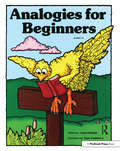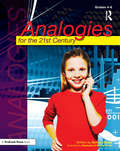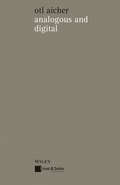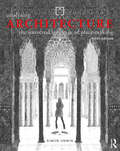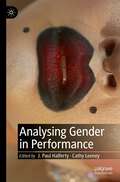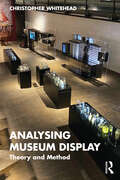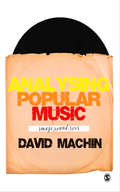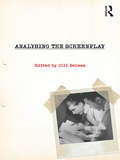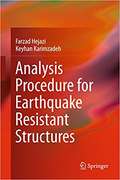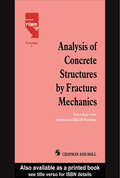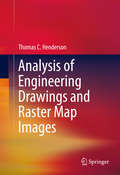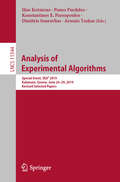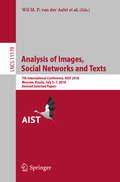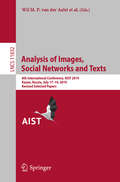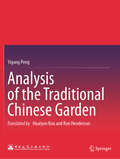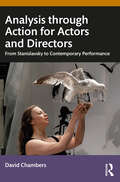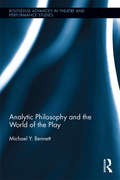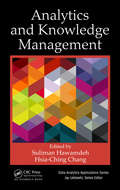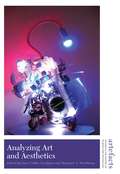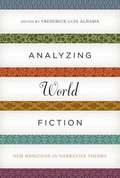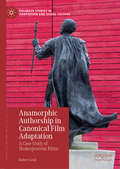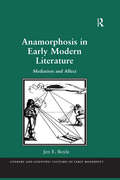- Table View
- List View
Analog und Digital: schriften zur philosophie des machens
by Otl AicherOtl Aicher (1922 –1991) war einer der herausragenden Vertreter des modernen Designs, er war Mitbegründer der legendären Hochschule für Gestaltung Ulm (HfG). Der heute geläu_ ge Begriff der visuellen Kommunikation ist auf ihn zurückzuführen. Was er seit den 1950er Jahren geschaffen hat, erinnert sei z. B. an die Piktogramme für die Olympischen Sommerspiele München 1972, gehört zu den ganz großen Leistungen der visuellen Kultur unserer Zeit.Ein wesentlicher Aspekt der Arbeiten von Aicher ist deren Verankerung in einer von Denkern wie Ockham, Kant oder Wittgenstein inspirierten „Philosophie des Machens“, die die Voraussetzungen und Ziele sowie die Gegenstände und Ansprüche von Gestaltung zum Thema hat. Aichers Schriften zu Fragen des Designs von der visuellen Gestaltung bis hin zur Architektur liegen in diesem Band in geschlossener Form vor.Wenn Aicher das Analoge und Konkrete dem Digitalen und Abstrakten vorzieht, tut er dies mit philosophischer Absicht. Er relativiert die Rolle der reinen Vernunft. Er kritisiert den Rationalismus der Moderne als Ergebnis der Vorherrschaft des bloß abstrakten Denkens. Wer das Abstrakte dem Konkreten vorzieht, missversteht nicht nur die wechselseitige Abhängigkeit von Begriff und Anschauung. Er schafft nach Aichers Urteil auch eine falsche Hierarchie, eine Rangordnung, die kulturell verhängnisvoll ist. Das digitale, Abstrakte ist nicht höher, größer und wichtiger als das Analoge, Konkrete.Wilhelm Vossenkuhl
Analogies for Beginners: Grades 1-3
by Lynne ChathamAn analogy is a comparison that points out the similarities between things that are different in all other respects. Teaching students how to solve analogies not only develops their logical thinking, but also builds visual awareness and verbal proficiency.The seven different types of visual analogies and 14 different verbal analogies in Analogies for Beginners are perfect for beginning lessons in logical reasoning, flexible thinking, and vocabulary. Each page gives students an example of the type of analogy that is being introduced and then provides 7 (visual) or 10 (verbal) problems for them to solve. This combination of verbal and visual formats is an ideal way to introduce logical thinking in primary grades. Whether you have time for one analogy a day or a worksheet a week, students will benefit in many ways when analogies are part of your curriculum. The use of visual analogies is beneficial for developing visual analysis even for older students, but especially useful for nonreaders and students with developing English skills. The verbal analogies provide students with exercises that require them to use word comprehension and also to examine various characteristics, uses, and relationships.This is one of a series of analogy books. For younger students, use First Time Analogies. For older students, use Thinking Through Analogies, Analogies for the 21st Century, or Advancing Though Analogies. Grades 1-3
Analogies for the 21st Century: Grades 4-6
by Bonnie L. RisbyThis is it! Here's the perfect venue for intermediate teachers to combine thinking skills and vocabulary development. Step into the 21st century with lessons that not only present students with analogies, but also provide them with instructions on how to best solve these verbal puzzles.An analogy is a comparison between two things. It points out the similarities or likenesses between things that might be different in all other respects. These exercises not only build thinking skills and make students more flexible and analytical; they also enhance vocabulary and writing skills.Intermediate students will get a jump on thinking skills and test taking strategies with these sure-to-please exercises. Whether this book is their first encounter with analogies or whether they are veterans with a great deal of experience, Analogies for the 21st Century gives them the tools they need in a fun-to-use format. It provides thinking strategies to help recognize the unique relationships between paired items and how these relationships can be replicated. Each lesson introduces new types of analogies, gives examples, and offers hints on solving the analogies. Vocabulary reflects today's culture, and helpful hints help students to build skills that will allow them to perform better on tests.This is one of a series of analogy books. For younger students, use First Time Analogies or Analogies for Beginners. For older students, use Thinking Through Analogies or Advancing Though Analogies. Grades 4-6
Analogous and Digital
by Otl AicherOtl Aicher (1922-1991) was an outstanding personality in modern design, he was a co-founder of the legendary Hochschule fur Gestaltung (HfG), the Ulm School of Design, Germany. His works since the fifties of the last century in the field of corporate design and his pictograms for the 1972 Summer Olympics in Munich are major achievements in the visual communication of our times. "An integral component of Aicher's work is that it is anchored in a "philosophy of making" inspired by such thinkers as Ockham, Kant or Wittgenstein, a philosophy concerned with the prerequisites and aims, the objects and claims, of design. Aicher's complete theoretical and practical writings on design (which include all other aspects of visual creativity, such as architecture) are available with this new edition of the classic work. If Aicher prefers the analogous and concrete to the digital and abstract he does it with a philosophical intention. He relativizes the role of pure reason. He criticizes the rationality of Modernism as a result of the dominance of purely abstract thinking. Anyone who prefers the abstract to the concrete does not only misunderstand the mutual dependence of concept and view. In Aicher's judgement he is also creating a false hierarchy, a rank order that is culturally fatal. Things that are digital and abstract are not greater, higher and more important than things that are analogous and concrete." Wilhelm Vossenkuhl
Analysing Architecture
by Simon UnwinNow in its fourth edition, Analysing Architecture has become internationally established as the best introduction to architecture. Aimed primarily at those wishing to become professional architects, it also offers those in disciplines related to architecture (from archaeology to stage design, garden design to installation art), a clear and accessible insight into the workings of this rich and fascinating subject. With copious illustrations from his own notebooks, the author dissects examples from around the world and all periods of history to explain underlying strategies in architectural design and show how drawing may be used as a medium for analysis. This new edition of Analysing Architecture is revised and expanded. Notably, the chapter on ‘Basic Elements of Architecture’ has been enlarged to discuss the ‘powers’ various architectural elements offer the architect. Three new chapters have been added to the section on ‘Themes in Spatial Organisation’, covering ‘Occupying the In-between’, ‘Inhabited Wall’ and ‘Refuge and Prospect’. Two new examples – a Mud House from Kerala, India and the Mongyo-tei (a tea house) from Kyoto, Japan – have been added to the ‘Case Studies’ at the end of the book. The ‘Select Bibliography’ has been expanded and the ‘Index’ revised. Works of architecture are instruments for managing, orchestrating, modifying our relationship with the world around us. They frame just about everything we do. Architecture is complex, subtle, frustrating… but ultimately extremely rewarding. It can be a difficult discipline to get to grips with; nothing in school quite prepares anyone for the particular demands of an architecture course. But this book will help. Analysing Architecture is the foundation volume of a series of books by Simon Unwin exploring the workings of architecture. Other books in the series include Twenty Buildings Every Architect Should Understand and Exercises in Architecture.
Analysing Architecture: the universal language of place-making
by Simon UnwinNow in its fifth edition, Analysing Architecture has become internationally established as the best introduction to architecture. Aimed primarily at those studying architecture, it offers a clear and accessible insight into the workings of this rich and fascinating subject. With copious illustrations from his own notebooks, the author dissects examples from around the world and all periods of history to explain the underlying strategies in architectural design and show how drawing may be used as a medium for analysis. In this new edition, Analysing Architecture has been revised and expanded. Notably, the chapter on ‘How Analysis Can Help Design’ has been redeveloped to clearly explain this crucially important aspect of study to a beginner readership. Four new chapters have been added to the section dealing with Themes in Spatial Organisation, on ‘Axis’, ‘Grid’, ‘Datum Place’ and ‘Hidden’. Material from the 'Case Studies' in previous editions has been redistributed amongst earlier chapters. The ‘Introduction' has been completely rewritten; and the format of the whole book has been adjusted to allow for the inclusion of more and better illustrative examples. Works of architecture are instruments for managing, orchestrating, modifying our relationship with the world around us. They frame just about everything we do. Architecture is complex, subtle, frustrating… but ultimately extremely rewarding. It can be a difficult discipline to get to grips with; nothing in school quite prepares anyone for the particular demands of an architecture course. But this book will help.
Analysing Gender in Performance
by J. Paul Halferty Cathy LeeneyAnalysing Gender in Performance brings together the fields of Gender Studies and Performance Analysis to explore how contemporary performance represents and interrogates gender. This edited collection includes a wide range of scholarly essays, as well as artists’ voices and their accounts of their works and practices. The Introduction outlines the book’s key approaches to concepts in English language gender discourses and gender’s intersectionalities, and sets out the approaches to performance analysis and methods of research employed by the various contributors. The book focuses on performances from the Global North, staged over the past fifty years. Case studies are diverse, ranging from site-specific, dance theatre, speculative drag, installation, and music video performances to Mabou Mines, Churchill, Shakespeare and Ibsen. Contributors explore how gender intersects with sexuality, social class, race, ethnicity, indigeneity, culture and history. Read individually or in tension with one another, the essays confront the contemporary complexities of analysing gender in performance.
Analysing Museum Display: Theory and Method
by Christopher WhiteheadAnalysing Museum Display is the first comprehensive book to bring together approaches to studying museum displays. Drawing on global examples, it reviews different theoretical frameworks and methods, charting major contributions to the field and exploring their potentials and limitations.How and why should we study museum display, and what is its nature as a complex form of representation? The book argues that display is at once material, experiential, and political in producing knowledge and that analysis requires rigorous conceptualisation and careful methodologies. It provides a critical guide to existing concepts and methods, exploring how museum display can be understood using semiotic, narrative, cartographic, and spatial analyses, assemblage theory, new materialist and multisensory approaches, and theories of affect, emotion, and historical positioning. Alongside this, Whitehead presents key orientations for research practice relating to objectivity and subjectivity, historical and contextual awareness, and mixing methods.Analysing Museum Display will be essential reading for scholars and students of museology at all levels. The book will also appeal to museum curators and professionals who are involved in the production of displays and wish to develop a more theorised and reflective perspective on their own practice.
Analysing Popular Music: Image, Sound and Text
by Mr David MachinPopular music is far more than just songs we listen to; its meanings are also in album covers, lyrics, subcultures, voices and video soundscapes. Like language these elements can be used to communicate complex cultural ideas, values, concepts and identities.<P> Analysing Popular Music is a lively look at the semiotic resources found in the sounds, visuals and words that comprise the 'code book' of popular music. It explains exactly how popular music comes to mean so much. Packed with examples, exercises and a glossary, this book provides the reader with the knowledge and skills they need to carry out their own analyses of songs, soundtracks, lyrics and album covers.<P> Written for students with no prior musical knowledge, Analysing Popular Music is the perfect toolkit for students in sociology, media and communication studies to analyse, understand - and celebrate - popular music.
Analysing the Screenplay
by Jill NelmesMost producers and directors acknowledge the crucial role of the screenplay, yet the film script has received little academic attention until recently, even though the screenplay has been in existence since the end of the 19th century. Analysing the Screenplay highlights the screenplay as an important form in itself, as opposed to merely being the first stage of the production process. It explores a number of possible approaches to studying the screenplay, considering the depth and breadth of the subject area, including: the history and early development of the screenplay in the United States, France and Britain the process of screenplay writing and its peculiar relationship to film production the assumption that the screenplay is standardised in form and certain stories or styles are universal the range of writing outside the mainstream, from independent film to story ideas in Bhutanese film production to animation possible critical approaches to analysing the screenplay. Analysing the Screenplay is a comprehensive anthology, offering a global selection of contributions from internationally renowned, specialist authors. Together they provide readers with an insight into this fascinating yet complex written form. This anthology will be of interest to undergraduate and postgraduate students on a range of Film Studies courses, particularly those on scriptwriting.
Analysis Procedure for Earthquake Resistant Structures
by Farzad Hejazi Keyhan KarimzadehOffers an analysis procedure for structures that are exposed to earthquakes and wind.<P><P> Provides civil engineers with clear guidelines on how to perform seismic analysis.<P> Covers numerous different building systems.<P>This book presents an analysis procedure for structures that are exposed to the lateral loads such as earthquake and wind. It includes the process for calculating and distributing the effective load into structural elements, as well as for calculating the displacements for different types of structures, e.g. reinforced concrete and steel framed structures. The book provides civil engineers with clear guidelines on how to perform seismic analysis for various building systems, and how to distribute the lateral load to the structural components. <P> This book consists of 4 chapters: The first chapter offers an introduction, while Chapter 2 discusses moment resistance frame. The final two chapters explore shear wall frames and brace frames respectively. Each chapter follows the same structure, explaining step by step all the necessary algorithms, equations and procedures for calculating 1) loads, 2) the centre of mass, 3) stiffness of structures, 4) centre of stiffness, 5) lateral loading, 6) the distribution of lateral loads, and 7) the lateral displacement.<P> Demonstrating the implementation of real building analysis, the book provides architectural drawings and structural plans at the beginning of each chapter.
Analysis of Concrete Structures by Fracture Mechanics: Proceedings of a RILEM Workshop dedicated to Professor Arne Hillerborg, Abisko, Sweden 1989
by S. P. Shah L. ElfgrenThis book presents the latest research findings of the fast developing applications of fracture mechanics to concrete structures. Key papers from leading experts in the field describe existing and new modelling techniques in the analysis of materials and structures. The book explains the practical application of fracture mechanics to structural mod
Analysis of Engineering Drawings and Raster Map Images
by Thomas HendersonThis book covers up-to-date methods and algorithms for the automated analysis of engineering drawings and digital cartographic maps. The Non-Deterministic Agent System (NDAS) offers a parallel computational approach to such image analysis. The book describes techniques suitable for persistent and explicit knowledge representation for engineering drawings and digital maps. It also highlights more specific techniques, e.g., applying robot navigation and mapping methods to this problem. Also included are more detailed accounts of the use of unsupervised segmentation algorithms to map images. Finally, all these threads are woven together in two related systems: NDAS and AMAM (Automatic Map Analysis Module).
Analysis of Experimental Algorithms: Special Event, SEA² 2019, Kalamata, Greece, June 24-29, 2019, Revised Selected Papers (Lecture Notes in Computer Science #11544)
by Panos Pardalos Ilias Kotsireas Konstantinos E. Parsopoulos Dimitris Souravlias Arsenis TsokasThis book constitutes the refereed post-conference proceedings of the Special Event on the Analysis of Experimental Algorithms, SEA² 2019, held in Kalamata, Greece, in June 2019.The 35 revised full papers presented were carefully reviewed and selected from 45 submissions. The papers cover a wide range of topics in both computer science and operations research/mathematical programming. They focus on the role of experimentation and engineering techniques in the design and evaluation of algorithms, data structures, and computational optimization methods.
Analysis of Images, Social Networks and Texts: 7th International Conference, AIST 2018, Moscow, Russia, July 5–7, 2018, Revised Selected Papers (Lecture Notes in Computer Science #11179)
by Vladimir Batagelj Panos M. Pardalos Andrey V. Savchenko Dmitry I. Ignatov Olessia Koltsova Wil M. P. van der Aalst Marcello Pelillo Alexander Panchenko Michael Khachay Natalia Loukachevitch Sergei O. Kuznetsov Irina A. Lomazova Amedeo Napoli Goran GlavašThis book constitutes the proceedings of the 7th International Conference on Analysis of Images, Social Networks and Texts, AIST 2018, held in Moscow, Russia, in July 2018. The 29 full papers were carefully reviewed and selected from 107 submissions (of which 26 papers were rejected without being reviewed). The papers are organized in topical sections on natural language processing; analysis of images and video; general topics of data analysis; analysis of dynamic behavior through event data; optimization problems on graphs and network structures; and innovative systems.
Analysis of Images, Social Networks and Texts: 8th International Conference, AIST 2019, Kazan, Russia, July 17–19, 2019, Revised Selected Papers (Lecture Notes in Computer Science #11832)
by Vladimir Batagelj Panos M. Pardalos Andrey V. Savchenko Dmitry I. Ignatov Wil M. P. van der Aalst Marcello Pelillo Michael Khachay Natalia Loukachevitch Sergei O. Kuznetsov Irina A. Lomazova Amedeo Napoli Valentina Kuskova Andrey Kutuzov Elena TutubalinaThis book constitutes the post-conference proceedings of the 8th International Conference on Analysis of Images, Social Networks and Texts, AIST 2019, held in Kazan, Russia, in July 2019. The 27 full and 8 short papers were carefully reviewed and selected from 134 submissions (of which 21 papers were automatically rejected without being reviewed). The papers are organized in topical sections on general topics of data analysis; natural language processing; social network analysis; analysis of images and video; optimization problems on graphs and network structures; and analysis of dynamic behavior through event data.
Analysis of the Traditional Chinese Garden
by Yigang PengAnalysis of the Traditional Chinese Garden is a seminal resource for the spatial principles and techniques that shape traditional Chinese gardens. It is a richly illustrated resource for historians, theorists, garden designers, landscape architects, architects and anyone interested in the design of these world renowned gardens with 106 pages of hand-drawn sketches by the author that vividly portray the intricacies and subtleties of traditional Chinese gardens. The book is widely known in China as a primary text for analysis of the gardens and was recognized with the inaugural National Excellent Architectural Book Award in 1990 and, since its debut in China in 1986, has garnered immense popularity and acclaim with 50 reprints and a total print run of 150,000 copies.
Analysis through Action for Actors and Directors: From Stanislavsky to Contemporary Performance
by David ChambersAnalysis through Action for Actors and Directors is a comprehensive view of an innovative and exciting process for making new theatre.As well as an understanding of how Analysis through Action has developed over time, this book also demonstrates how it can be put into practice in today’s theatre. The first part of this book traces the exciting genealogy from Stanislavsky’s unfinished experiments, through the insights of geniuses Maria Knebel and Georgii Tovstonogov, down to today’s avant-garde auteurs. The second part is a practical manual based on extensive field testing by the author and colleagues. Here, two key components of the process are elucidated: Text Actions – ten interwoven text analysis steps – to be twinned with the thrilling rehearsal process using focused and joyful improvisations called Études.Written for new or experienced theatre students and practitioners, this book will enrich the technique of any theatre artist and anyone else interested in the theatre and its future.
Analytic Philosophy and the World of the Play (Routledge Advances in Theatre & Performance Studies)
by Michael Y. BennettTheatrical characters’ dual existence on stage and in text presents a unique, challenging case for the analytical philosopher. Analytic Philosophy and the World of the Play re-examines the ontological status of theatre and its fictional objects through the "possible worlds" thesis, arguing that theatre is not a mirror of our world, but a re-creation of it. Taking a fresh look at theatre’s key elements, including the hotly contested relationships between character and actor; onstage and offstage "worlds"; and the play-text and performance, Michael Y. Bennett presents a radical new way of understanding the world of the play.
Analytics and Knowledge Management (Data Analytics Applications)
by Suliman Hawamdeh and Hsia-Ching ChangThe process of transforming data into actionable knowledge is a complex process that requires the use of powerful machines and advanced analytics technique. Analytics and Knowledge Management examines the role of analytics in knowledge management and the integration of big data theories, methods, and techniques into an organizational knowledge management framework. Its chapters written by researchers and professionals provide insight into theories, models, techniques, and applications with case studies examining the use of analytics in organizations. The process of transforming data into actionable knowledge is a complex process that requires the use of powerful machines and advanced analytics techniques. Analytics, on the other hand, is the examination, interpretation, and discovery of meaningful patterns, trends, and knowledge from data and textual information. It provides the basis for knowledge discovery and completes the cycle in which knowledge management and knowledge utilization happen. Organizations should develop knowledge focuses on data quality, application domain, selecting analytics techniques, and on how to take actions based on patterns and insights derived from analytics. Case studies in the book explore how to perform analytics on social networking and user-based data to develop knowledge. One case explores analyze data from Twitter feeds. Another examines the analysis of data obtained through user feedback. One chapter introduces the definitions and processes of social media analytics from different perspectives as well as focuses on techniques and tools used for social media analytics. Data visualization has a critical role in the advancement of modern data analytics, particularly in the field of business intelligence and analytics. It can guide managers in understanding market trends and customer purchasing patterns over time. The book illustrates various data visualization tools that can support answering different types of business questions to improve profits and customer relationships. This insightful reference concludes with a chapter on the critical issue of cybersecurity. It examines the process of collecting and organizing data as well as reviewing various tools for text analysis and data analytics and discusses dealing with collections of large datasets and a great deal of diverse data types from legacy system to social networks platforms.
Analyzing Art and Aesthetics (Artefacts: Studies in the History of Science and Technology #9)
by Margaret A. Weitekamp Anne Collins GoodyearThis ninth volume of the Artefacts series explores how artists have responded to developments in science and technology, past and present. Rather than limiting the discussion to art alone, editors Anne Collins Goodyear and Margaret Weitekamp also asked contributors to consider aesthetics: the scholarly consideration of sensory responses to cultural objects. When considered as aesthetic objects, how do scientific instruments or technological innovations reflect and embody culturally grounded assessments about appearance, feel, and use? And when these objects become museum artifacts, what aesthetic factors affect their exhibition? Contributors found answers in the material objects themselves. This volume reconsiders how science, technology, art, and aesthetics impact one another.
Analyzing Narrative: Discourse and Sociolinguistic Perspectives
by Anna De Fina Alexandra GeorgakopoulouThe socially minded linguistic study of storytelling in everyday life has been rapidly expanding. This book provides a critical engagement with this dynamic field of narrative studies, addressing long-standing questions such as definitions of narrative and views of narrative structure but also more recent preoccupations such as narrative discourse and identities, narrative language, power and ideologies. It also offers an overview of a wide range of methodologies, analytical modes and perspectives on narrative from conversation analysis to critical discourse analysis, to linguistic anthropology and ethnography of communication. The discussion engages with studies of narrative in multiple situational and cultural settings, from informal-intimate to institutional. It also demonstrates how recent trends in narrative analysis, such as small stories research, positioning analysis and sociocultural orientations, have contributed to a new paradigm that approaches narratives not simply as texts, but rather as complex communicative practices intimately linked with the production of social life.
Analyzing World Fiction
by Frederick Luis AldamaWhy are many readers drawn to stories that texture ethnic experiences and identities other than their own? How do authors such as Salman Rushdie and Maxine Hong Kingston, or filmmakers in Bollywood or Mexico City produce complex fiction that satisfies audiences worldwide? In Analyzing World Fiction, fifteen renowned luminaries use tools of narratology and insights from cognitive science and neurobiology to provide answers to these questions and more. With essays ranging from James Phelan’s “Voice, Politics, and Judgments in Their Eyes Were Watching God” and Hilary Dannenberg’s “Narrating Multiculturalism in British Media: Voice and Cultural Identity in Television” to Ellen McCracken’s exploration of paratextual strategies in Chicana literature, this expansive collection turns the tide on approaches to postcolonial and multicultural phenomena that tend to compress author and narrator, text and real life. Striving to celebrate the art of fiction, the voices in this anthology explore the “ingredients” that make for powerful, universally intriguing, deeply human story-weaving. Systematically synthesizing the tools of narrative theory along with findings from the brain sciences to analyze multicultural and postcolonial film, literature, and television, the contributors pioneer new techniques for appreciating all facets of the wonder of storytelling.
Anamorphic Authorship in Canonical Film Adaptation: A Case Study of Shakespearean Films (Palgrave Studies in Adaptation and Visual Culture)
by Robert GealThis book develops a new approach for the study of films adapted from canonical ‘originals’ such as Shakespeare’s plays. Departing from the current consensus that adaptation is a heightened example of how all texts inform and are informed by other texts, this book instead argues that film adaptations of canonical works extend cinema’s inherent mystification and concealment of its own artifice. Film adaptation consistently manipulates and obfuscates its traces of ‘original’ authorial enunciation, and oscillates between overtly authored articulation and seemingly un-authored unfolding. To analyse this process, the book moves from a dialogic to a psychoanalytic poststructuralist account of film adaptations of Shakespeare’s plays. The differences between these rival approaches to adaptation are explored in depth in the first part of the book, while the second part constructs a taxonomy of the various ways in which authorial signs are simultaneously foregrounded and concealed in adaptation’s anamorphic drama of authorship.
Anamorphosis in Early Modern Literature: Mediation and Affect (Literary and Scientific Cultures of Early Modernity)
by Jen E. BoyleAnamorphosis in Early Modern Literature explores the prevalence of anamorphic perspective in the seventeenth and eighteenth centuries in England. Jen Boyle investigates how anamorphic media flourished in early modern England as an interactive technology and mode of affect in public interactive art, city and garden design, and as a theory and figure in literature, political theory and natural and experimental philosophy. Anamorphic mediation, Boyle brings to light, provided Milton, Margaret Cavendish, and Daniel Defoe, among others, with a powerful techno-imaginary for traversing through projective, virtual experience. Drawing on extensive archival research related to the genre of "practical perspective" in early modern Europe, Boyle offers a scholarly consideration of anamorphic perspective (its technical means, performances, and embodied practices) as an interactive aesthetics and cultural imaginary. Ultimately, Boyle demonstrates how perspective media inflected a diverse set of knowledges and performances related to embodiment, affect, and collective consciousness.

